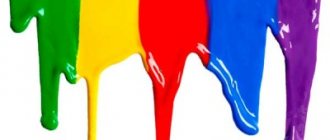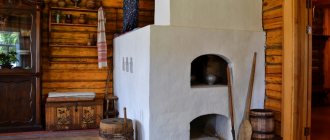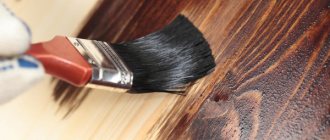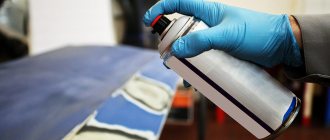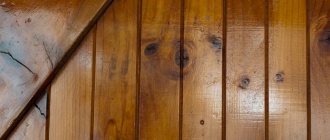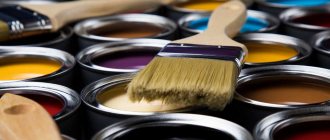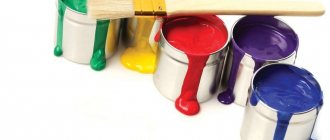To begin with, I would like to voice some tips on what is called preventive measures. If the surface will be subject to frequent rubbing, the risk of being smeared or blurred, then it is best to use acrylic water-dispersed paint. Polyvinyl acetate dispersion and styrene butadiene dispersion behave rather poorly in “problem” areas. The latter are quite capricious and sensitive to mechanical stress and light - they get very dirty, lose their color and are difficult to wash. Acrylic dispersion is a little more expensive, but it washes well and dirty areas will not require you to take a radical approach - repainting, but can simply be washed.
In order not to spend money on varnishing, just prefer acrylic water-dispersion paint, which is moisture-resistant, resistant to mechanical damage and washable.
Now about the additional protection of water-dispersion coatings that do not meet such extreme operating conditions.
Any water-based acrylic varnish will work here.
Application is carried out in several layers. For better adhesion, after the first dry layer, you can lightly grout and apply the next layer. This coating will be washable. And the varnished surface gets dirty much less. However, the entire fragment (a wall, a partition, or even the entire room) will have to be subjected to such processing, because it will be quite difficult to precisely match the tone. You can, of course, do it with a spray gun, with the tone transitioning “to zero,” but not everyone has a spray gun, and this cannot be achieved with a brush. That's why I say that it would be preferable to immediately choose paint that is resistant to washing and abrasion. Varnish will only help to “fix” or protect the most problematic areas, such as door slopes, wall areas near switches and sockets, walls behind ottomans and locker rooms. In general, where it gets dirty most often.
a) since the paint is whitening, then you CANNOT varnish it right away, but first buy INTERIOR and go over it b) all varnishes give a yellow tint, and even more so alkyd ones, and, besides, alkyd varnishes turn yellow later
I have an experiment in the kitchen: interior Royal! !
so I scrub it with a brush and powder))
I’m just thinking about how to rip it off during the next repair.
Read also: Eustoma white flower photo
Classification of varnishes by purpose
Varnishes are used primarily for treating wooden surfaces, but they can be used to treat products and substrates after painting - brick, concrete, plaster. Compositions are divided into several broad groups depending on their purpose:
- For processing furniture and surfaces made of natural wood. Varnish is used for interior work. The composition of the varnishing agent can include coloring pigments for additional tinting of products, or the solutions can be tinted immediately before applying the varnish layer.
- For finishing parquet and parquet flooring. High-density varnishes help protect wooden floors from negative impacts and emphasize the woody texture of the natural material. They are characterized by resistance to abrasion and form a thin film.
- For decorative varnishing of walls indoors and outdoors. Universal products are characterized by acceptable resistance to moisture, ultraviolet radiation and are affordable. Using such products, you can varnish walls painted with various types of paint.
- Highly resistant yacht varnishes. They are advisable to use when treating surfaces and products that are often in contact with a damp environment. Used for finishing window frames on the street side, door frames, garden furniture, gazebos and other wooden structures.
What varnish should I use to protect a product or material? It depends on the surface being treated. Different compositions are intended for finishing wooden, brick or metal surfaces. It is necessary to take into account what kind of paint the base is painted with (water-based or non-water-based), as well as the location of the work - walls, facades, furniture.
On video: the intricacies of varnishing wooden products.
How to wash off soot and grease
The task becomes more complicated if grease or soot has accumulated on the water-based paint, which often happens with kitchen walls. In such cases, you need to use more effective means. A home method is suitable: a solution of soda (3 tablespoons per bucket of water), applied to the stain and left for 20-30 minutes, not until completely dry.
After this, the dirt can be easily washed off with a regular sponge. With the same success, you can use table salt to wash the walls if there is no soda in the house. To wipe walls coated with water-based paint, it is better to use a soft cotton cloth. You can also wipe such surfaces with a mild soap solution.
Types of product by composition
On the modern paint and varnish market you can purchase a wide variety of varnishes. Solutions can give a glossy or matte effect, leave a transparent and pigmented layer, and contain craquelure, mother-of-pearl, and glitter. The entire variety of products for varnishing can be divided into several types depending on the composition:
- Water-based acrylic. Safe, environmentally friendly composition. The use of acrylic is suitable for processing wooden surfaces, acrylic plaster and plaster.
- Oil based on natural or synthetic resins and oils. Penetrates deeply into the internal structure of the material, takes a long time to dry, and forms a durable coating.
- Alkyd for exterior use and wood products. It has good moisture resistance and is universal in use. The composition contains alkyd resins and synthetic solvents.
- Polyurethane universal type. Resistant to any type of impact (scratches, moisture, chemicals). Combines with different types of materials and paints.
- Quick drying nitro varnish. It adheres well to the treated surface, but is highly toxic. Capable of dissolving some types of paints.
- Epoxy for rooms with high humidity. It has good strength characteristics, high drying speed and attractive appearance.
In order not to make a mistake with the choice of varnish for different surfaces, you need to choose compositions from the same group. For example, acrylic paint can be coated with acrylic varnish. It is important to take into account that water-based acrylic paints that are not resistant to moisture can be partially washed off.
How to coat acrylic paint with varnish - application instructions
Acrylic paints have one interesting feature: the longer they are left unvarnished, the more firmly they “bond” with the wooden base. Before choosing a varnish, the paint must be allowed to dry thoroughly, from several days to several weeks. While drying, the painted product can be protected with film or glass.
Features of MDF varnishing
When finishing furniture and doors, varnish is used to give products a more interesting color and protect them from damage. MDF fiberboards differ from natural wood in structure, so a two-component varnish is suitable for processing them. With its help, it is possible to give products an unusual effect and make the material resistant to temperature and moisture.
Requirements that varnish for coating MDF panels must meet:
- two-component, odorless product;
- moisture resistance and heat resistance;
- high antiseptic characteristics;
- optimal drying time – up to 72 hours;
- operating temperature of use - +5+25°C;
- content of volatile substances within 20%;
- material consumption rate – up to 0.5 kg per 1 m2.
MDF panels can be coated with a synthetic product to achieve a glossy effect, or water-based acrylic varnish can be used to give the surface a matte finish. The coating is applied to the slabs with a brush or spray.
Preparation and varnishing of MDF includes the following steps:
- Before varnishing, a primer is applied to the MDF panels and the damaged areas are treated with putty.
- The product is sanded with fine-grained sandpaper and a second layer of primer is applied.
- They are varnished, difficult areas are treated with a brush, and then the main part of the furniture facade, panel or door is varnished.
Since the varnish for MDF is based on two components, before work they are combined and stirred with a construction mixer, and the mixture must be filtered. The prepared working solution must be used within three hours. Can it be used later? Not recommended.
Why varnish
It has been established that acrylic paint is classified as one of those types of finishing compositions that do not require varnishing. It already contains varnish. It can independently counteract the influence of moisture. Varnishing is a desire to achieve increased strength. Many people ask whether it is necessary to varnish the paint. The material being processed plays a role. For wood painted with acrylic, protection is considered optimal. Wood is afraid of water, is easily exposed to high and low temperatures with subsequent defects, and is not able to resist various pests in its pure form. Painting and varnishing provide double protection.
Securing gouache with varnish
When performing creative woodworking, creating decorative objects from plaster, painting and decoupage, artistic paints are used. After application, the gouache must be fixed so that the paint layer is resistant to abrasion, cracking and moisture. Some paints under incorrectly chosen varnishes “float” and become smudged. To avoid this, cover the design (ornament, pattern) with acrylic or alkyd paint.
The procedure for working with acrylic varnish:
- Traditionally, gouache varnishing is done using wide synthetic brushes with long bristles. Some artists use aerosols to avoid smudging the gouache.
- The use of a roller, sponge and sponges is appropriate only if it is necessary to obtain a certain decorative effect. Tools for work must be dry and clean.
- Select an effect. The glossy composition gives a pleasant shine, but when exposed to light, the work will reflect glare. Matte varnishing can mute the shades. The output is a semi-matte composition.
- When using a brush, the tool is dipped in varnish and squeezed well on the edge of the container. The varnish is applied with intense strokes. The acrylic composition is white, the treated areas are clearly visible.
- To achieve the desired effect of a varnished surface, several thin layers can be applied, allowing a drying interval of two to three hours.
Some products decorated with artistic painting using gouache are often used in everyday life. How to fix gouache so that the coating lasts longer? It is recommended to perform multi-layer varnishing. To do this, acrylic varnish is applied at least ten times, dried and lightly processed with fine sandpaper.
Some craftsmen use strong-hold hairspray to fix gouache; they use polyurethane compounds, furniture and yacht varnishes. The choice of product also depends on the color saturation of the gouache. Thus, red gouache under nitro varnish will flow, and light paints may acquire a yellowish tint when using alkyd PF compositions.
Main differences
The properties of the materials are presented in the table.
Compatibility of coloring agents
There is no need to combine formulations. Alkyd is a good primer for wooden surfaces. It is also suitable as a finishing varnish if applied in several layers.
Acrylic paint is elastic; it is optimal to use it on products subject to linear expansion due to temperature changes and humidity changes.
Is it possible to combine enamels?
To work on the same surface, you need to use products on the same basis.
Soft compounds can be applied to hard surfaces, but not vice versa.
Alkyd enamel is hard, works as a primer under a varnish layer or a softer coating
. Acrylic is an elastic covering material. Can be applied to oily, dried or old bases. But in this case, the service life of the finishing layer is reduced by 2 times.
The combination is suitable for wood. On surfaces made of other materials there is no point in mixing layers.
What not to do
Do not apply alkyd enamel to acrylic surfaces. If this is still necessary, you need to remove as much of the old coating as possible, sand it thoroughly, then prime it.
Do not mix dissimilar components. Acrylic-alkyd enamel can only be produced industrially using special technologies. It is not used in construction.
Conclusion
The article compares two materials. It's impossible to say which one is better. When choosing, you need to take into account the expected service life of the coating, operating conditions, quality of the finished surface, and budget for repairs.
Consumers are often faced with a choice: which paint to prefer - acrylic or alkyd? To answer this question, it is necessary to understand the features of these compositions, their advantages and disadvantages.
How to varnish water-based paint?
For interior decoration, water-dispersion and water-based paints are increasingly used. There is no fundamental difference between them, and the only difference is the degree of coverage. To preserve the pleasant color of a surface painted with water-based paint, you can use varnishes. But you need to use formulations with similar characteristics.
Water-based paint comes in different types, so each option requires a separate water-based varnish:
- Water-based acrylic paint requires a preliminary application of acrylic primer and then an acrylic-based water-based paint varnish.
- Silicone-based water-based paint cannot be varnished, since it penetrates deeply into the internal structure of the material.
- Acrylic water-based paint can be treated with medium-viscosity polyurethane varnish. The surface of the walls is easy to clean, the integrity of the coating remains for several years.
- Nitrovarnishes for water-based paint partially dissolve the composition, so they must be used very carefully. In addition, nitro varnishes emit toxins and are best used for outdoor use.
Alkyd varnishes can be used to coat wooden surfaces treated with alkyd enamels. If the wood is painted with water-based acrylic paint, then acrylic varnish is chosen to protect the coating.
The main rule of varnishing technology for various surfaces is that paint and varnish compositions must be included in the same group, that is, have the same characteristics of substances at the molecular level. The use of varnish has both a decorative and protective function, extending the life of products, objects and surfaces.
Master classes on varnishing (2 videos)
Different types of varnishes (30 photos)
Rules for varnishing using water-based dyes
Varnish is not applied to all types of water-based emulsions. Is it necessary to varnish acrylic paint, if in this case it acts as a protective layer, the answer is yes. Other types of CM on water independently form a film on the surface and do not need protection.
The protective layer will be thin and distributed evenly over the entire surface to be treated if it is applied with a roller.
Important: acrylic varnish compositions with a tinting effect are not applied to surfaces containing water-based emulsion. They have a wood tint, so they will mute the color of the acrylic. Only brown dye with a tinting coating will look harmonious. LM Lakra, water-dispersed, tinted, 4603292005652, colorless, 0.9 kg for 172 rubles.
Recommended varnish for water-based paint: universal, colorless, for stone. LM Profiwood acrylic for stone, concrete, brick, wood (1/2.2 l) – 600 rubles; Universal acrylic LM Ispolin 2l for 370 rubles; Protection V33 for countertops 0.5 l, colorless for 855 rubles.
Varnishing with a water-based composition will be of high quality if the operating rules are followed:
- The varnish material is diluted to the desired consistency with water.
- The liquid mass is thoroughly shaken before application.
- If the old coating layer is not removed, its compatibility with the varnish is always checked.
- The varnish coating dries evenly if the sun's rays do not fall on it and there is no movement of air masses or drafts.
Technique for applying varnish to acrylic paint:
- The varnish composition for the dye is selected. A matte finish is recommended; acrylic has its own shine.
- The surface is cleaned and dried. You cannot remove dust with a damp cloth from a freshly painted surface. Traces may remain.
- It is recommended to heat the varnish to 40-50°C in a water bath. A three-liter jar is lowered into a liter container of boiling liquid for 5 minutes. During heating, the mass is thoroughly stirred. This procedure can be done if you do not have a building thermometer.
- If a brush is selected for applying LM, then it is better to choose a wide flute brush 50-150 mm wide. The varnish mixture is poured onto the painting tool in a small portion so that it does not drip. A minimum of 2 coats are applied. Hand movements should be smooth and smooth.
- Between layers a time interval of 2 to 4 hours is maintained.
- It is recommended to sand the first layer with 280-320 sandpaper. The dust is removed and a second layer of varnish is applied.
- The treated areas are covered with protective coatings to prevent dust from settling on them.
Difference between "dilute" and "dissolve"
A significant difference between the products: solvents affect the hardness of the varnish substance, thinners affect its viscosity. In order not to spoil the material, you need to know what is being diluted and diluted with.
Water-based materials can be diluted with water or glycol ether. Dissolve with xylene, glycol ether, combined solvent. Compositions based on organic solvents are diluted with toluene, turpentine, and those types of eluents that are already contained in the varnish.
How to choose decorative paint or varnish?
Transparent varnishes are available that will refresh the surface, paint in any shade, multi-colored shiny coatings, with the effect of brocade, pearls or metal. What kind of interiors do they work in?
The wall paint market is incredibly diverse, and provides the opportunity to realize even the most inventive ideas. Decorative paint with glitter, acrylic or water-based, in the form of a gel or even a spray, adds a glamorous accent to the interior. Small particles strongly scatter light and illuminate the room, making it visually more spacious.
- Varnish. One possibility is to use a silk effect clear varnish that is applied to a previously painted wall in the color of your choice. Thanks to this, every surface will glow without changing the original color. The main purpose of varnish is to protect the walls so that they can be cleaned. In addition, it serves to achieve appropriate decorative effects. These varnishes can be used on the following wall coverings:
- all types of satin and latex paints;
- structural plasters;
- stucco;
- Venetian plaster;
- travertine;
- textured coatings;
- liquid wallpaper;
- many other interior items.
- Another option is to choose decorative paint with a specific color. This is the perfect way to change up your interior or freshen up your walls. The color palette is very wide, and each manufacturer offers interesting shades that match many finishing styles.
Wall paint with glitter, photo
Having chosen such a product, we need to think about what effect we want to achieve. The range includes both traditional, pearl and metallic effects in different shades.
Advice:
- silver harmonizes perfectly with cool tones;
- gold and fashionable copper - with warm colors.
You can experiment with combinations of different layers of paint. For example, textured paint will give the wall a rough surface, while covering it with emulsion paint with a gloss will cause the sun's rays to refract on its surface. This creates a very pleasing result and can be a great suggestion when decorating a child's room, where such "glitter" will certainly be well received.
In what interior will glitter work?
The use of paint with a silk effect, gold or metallic sheen is a strong decorative element that will not leave anyone indifferent. It is worth considering this choice carefully so that the interior does not create too intense an effect. Below are some tips and solutions.
A glossy finish is recommended as an accent, for example by painting one wall:
- in the bedroom you can decorate the headboard of the bed with silk, this will make the headrest more noticeable and give it elegance;
- This is also a great idea in the kitchen or bathroom, a shiny kitchen backsplash diffuses light like a mirror;
- in the living room, a contrasting wall behind the sofa will look very impressive;
- If the room has a building pillar, cornice or openwork wall, there is no need to hide them; a shiny coating from an unwanted structural element will create a decorative highlight.
You can apply interesting patterns to walls or even furniture using a stencil.
How to paint walls, apply varnish?
Such work does not require special skills. These products can be self-applied. It is recommended to use a brush for application. This is a slightly more labor-intensive method than a roller, but it allows the compound to penetrate into each cavity and coat the surface evenly.
Decorative and protective varnishes are applied in two stages:
- The substrate prepared for painting should be coated with washable paint and allowed to dry for approximately 5 hours.
- Then the varnish is applied to the previously painted wall using a brush or roller with short bristles. Before application, gloss is added to the varnish and stirred (do not use an electric stirrer).
It is better to carry out work at a temperature of 18-25 °C.
Walls shouldn't just be a boring backdrop for decorating an apartment. There are many ways to make a room interesting. One of them is coloring with various effects. Particularly impressive is the shine on the walls, which diffuses light and looks very stylish. Decorating walls in this way does not require purchasing expensive paint. You can buy ready-mixed paints, or add shine yourself in the selected proportion. However, even if we want to apply glitter to a surface that has been painted before, we don't have to worry about decorating the walls being time-consuming and expensive - decorative varnish will easily cope with this task.
Standard paint consumption
| Paint type | Paint consumption m2/l | Number of layers | Drying time |
| Water-based | 0,15-0,2 | 1 | 2-3 hours |
| Acrylic | 0,2-0,25 | 2 | 2-3 hours |
| Texture | 0,3-0,5 | 1-2 | 24 hours |
| Cement based | 0,5-0,9 | 1-2 | 24 hours |
Choose calm weather for exterior painting, otherwise the new decor may be ruined by dust settling on the paint. Apply paint with a brush, roller or spray. If the instructions require a two-layer coating, apply the second layer only after the previous one is completely ready.
Varnishing creative crafts
Painting on wood and decorating plaster objects with artistic paints will decorate the interior of any home. To prevent the beautiful coating from being damaged by moisture or cracking, it is fixed to the base. If the paints and varnish do not match each other, then the decor floats and gets smeared. At home, paintings are done with acrylic paints. It is recommended to coat a household item with such decor, used in everyday life, with acrylic varnish to secure the gouache. It is applied 10 times. Each layer is dried and processed with fine-grain sandpaper.
Types of acrylic-based varnishes
Acrylic is the name of polymer materials based on derivatives of acrylic acid, the simplest representative of carboxylic acids. The clear liquid has a pungent odor. Acrylic is soluble in water, chloroform, ethanols, diethyl ethers. The pure material has excellent physical and technical characteristics:
- not affected by temperatures;
- resistant to ultraviolet radiation;
- in connections it acquires good strength;
- has a number of positive mechanical characteristics.
To obtain paint and varnish products to create a decorative protective coating, a special organic solvent or water is added to acrylic. The composition, where an organic solvent is added, can be used for varnishing not only wooden, but also metal, glass, and stone surfaces.
Universal acrylic thinner.
Water-dispersed acrylic varnish
This varnish is as environmentally friendly as possible and is suitable for interior work. Emphasizes the natural texture of wood (if it is parquet, furniture, caisson, panels, etc.). It is easy to apply, dries in a matter of hours, and has excellent adhesion. The finishing coating is strong, durable, slightly susceptible to abrasion and the influence of physical and chemical environments. Has excellent decorative qualities.
If the aqueous dispersion of acrylic resins thickens or the mixture is immediately too viscous, it can be diluted. Aqueous solvent up to 5-10% of the total weight of the varnish is allowed - without loss of material properties.
It is not recommended to mix this type of paint and varnish materials with other types of parquet chemicals. It is forbidden to use them as a solvent, drying oil, gasoline, acetone, white spirit and other organic eluents.
Water-dispersed acrylic varnish decorates and protects the material from harmful external influences.
Acrylic varnish based on organic solvents
The solvent here is a mixture of esters, ketones, and aromatic hydrocarbons. Sometimes the solution contains plasticizers. The resulting protective film is quite durable and does not turn yellow over time.
Technical characteristics include good adhesion to the base, water resistance, and smooth application. The material can be used for external and internal work. Unlike water-based varnishes, this group of materials has a characteristic odor, which can be noted as a disadvantage. But after the varnish has completely dried, this defect will disappear.
In order to wash painting tools after work or to dilute thickened acrylic varnish, you need a strong solvent. This is usually turpentine or another universal eluent. It is recommended to apply the product in 2-3 layers. Moreover, to apply the first layer, acrylic varnish based on organic solvents must be diluted by 30%. This is necessary to enhance the wear resistance of the protective coating.
The best choice of material for the bathroom
Which composition do you prefer? Each type has its own advantages. When choosing paint for finishing a bathroom, be guided first of all not by price, but by the reputation of the manufacturer.
There are many well-known brands operating in the paint and varnish market. Self-respecting manufacturers have a line of moisture-resistant paints. The compositions of well-known companies received the highest ratings from consumers.
Tikkurila
The popular Finnish brand belongs to one of the oldest manufacturers of various types of paint and varnish products.
Moisture-resistant paint Luja has been developed for finishing bathrooms. Semi-gloss and semi-matte options include a moisture-proofing primer. This brand sells high-quality products from Germany. Jobi Wasch Fest waterproof bathroom paint has extremely positive reviews. True German quality and reasonable prices characterize compounds with high resistance to steam and water.
Dulux
The products of the famous international paint and varnish concern can be found in all major construction supermarkets. Excellent quality and a rich palette are the advantages of Dulux paints. The Realife Kitchen & Bathroom line has been created to decorate bathroom walls.
Advice. Don't save money! When buying cheap paint from a little-known manufacturer, you risk getting a low-quality product with questionable performance characteristics. The composition often contains substances hazardous to health.
Read about choosing a spray gun for water-based paint, as well as how to dilute acrylic paint
Decorative features of varnished surfaces
Basically, consumers require either a mirror gloss or a discreet matte finish. This can be achieved with acrylic or polyurethane varnish. But with the addition of various components, you can give surfaces a completely unique decorative look.
For wooden surfaces, technologies of artificial aging, tinting, and enhancing textural depth are often used. What kind of varnish can you use to open up walls in an unusual way?
- Craquelure varnish - creates an imitation of a naturally aged cracked surface on a plastered wall. The network of cracks is obtained by applying a two-layer crackle varnish with additional patination of the cracks.
- Pearlescent varnish – used as a finishing decorative finish, creates a unique spectral shimmer effect. Produced on an acrylic base. Used to protect and decorate plaster, paintable wallpaper, mineral and wooden surfaces.
- Glitter varnish - available in the form of an acrylic mixture with glitter for finishing surfaces. The decorative additive can be purchased separately in a wide range of colors. Thus, by mixing the components yourself, any painting mixture can be made with glitter.
Whatever varnish you use to protect wooden and other surfaces inside and outside the house, be sure to adhere to the application technology and technical requirements when working. During the drying period of the varnish, you should also follow some rules.
If you are not sure that you can handle the task yourself, entrust it to professionals. Experts in matters of high-quality repairs and construction will help you select the necessary materials, and will also carry out everything at a high professional level.
